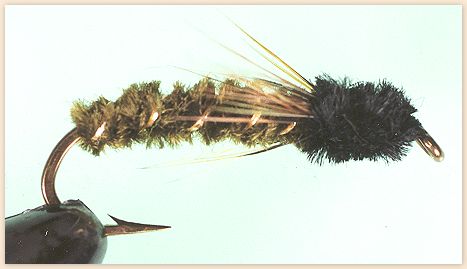
LITTLE JEWEL
Hook: Mustad 9672 (or equivalent 3XL), 8 - 16.
Thread: Black 6/0, prewaxed.
Abdomen: Dark-olive (peacock green) chenille,
sizes medium to extra small, depending on the size of
the hook.
Ribbing: Small 16/18 gold mylar.
Hackle: Brown furnace saddle hackle feather,
3 wraps, trimmed top and bottom.
Thorax: Black chenille, large to small. The
thorax should be one to two sizes larger than the abdomen.
Head: Black.
TYING TIPS: Proportions are very important with
this pattern. Tie it only as small as the chenille you
can find. Size 14 patterns require extra small (00) abdomen
chenille, with small (o) size for the thorax. Size 12 can
get by with small for the body, and medium (1) for the
thorax. Size 8s and 10s will need medium for the abdomen,
and large (2 or 3) for the thorax. When I tie as small
as 16, I generally use the new dark-olive 6/0 Flymaster
thread for the abdomen, and 00 chenille for the thorax.
According to my fishing logs, I first dressed this
pattern in the spring of 1971. I had been
been camped at southwest Idaho's Crane Falls Lake,
when I found some caddis stillborns floating in
the film. I determined their approximate shape
and color and experimented with several designs
over the weekend. I eventually narrowed my assortment
down to three patterns. During the following weeks,
I eliminated two of them.
The pattern I kept still didn't have a name, when
several years later, Boisean Ken Magee and I were
fishing Jewel Lake near Sandpoint. I was catching
lots of fish with the fly. Ken said we should name
the fly. Since I was doing so well with it at this
little northern Idaho cutthroat lake, we called it
my "Little Jewel."
As with my other chenille-bodied patterns, this one
has many potential variations. It can be dressed
with abdomens of brown, gray, tan, cream, yellow,
white, bright green, light olive, black, or any of
my popular variegated chenilles. I usually use a
black thorax on the fly, but at times will match
the color of the abdomen.
As this pattern was being developed, I had been using
Ernest Schweiber's, Nymphs, as my primary
reference book. His color plate of Trichoptera (caddis)
pupas on page 86, influenced a wide assortment of "Little
Jewels" in my fly boxes. Schweibert shows 15 color
variations in his plate and I suppose I've tied up
chenille variations of all of them. Almost half of
Ernie's pupas will be covered with my dark-olive bodied
Little Jewel.
One variation I tied for several seasons, was my Horsethief
Green Caddis. The abdomen was chartreuse green, and
the thorax was reddish-brown. I developed the pattern
after I saw a number of large, similarly colored caddis
pupas hatch out one weekend at Horsethief Reservoir.
My pattern was perfect. For a couple of years I caught
quite a few fish with the fly. Then the caddis seemed
to disappear when the lake was drained to eradicate an
illegally stocked perch population. I haven't observed
the natural in the lake for the past 15 or 20 years.
Besides Nymphs, I use two other entomology
reference books: Dave Whitlock's Guide To Aquatic Trout
Foods, and Western Hatches, by Dave
Hughes and Rick Hafele. When I published my User Friendly
Guide To Aquatic Entomology (now out of print), these
three books gave me the answers to many of my questions.
They still do.
FISHING TIPS: As with so many of my stillwater
nymphs, this pattern needs to be fished with a fairly
steep "angle of emergence." When caddis pupas emerge,
they often do so in a hurry. Count your fly down to
the bottom, then fish with a fairly fast retrieve.
After a few casts, speed up your retrieve.
The tippet size is determined by the size of the fly
and the size of the fish.
The knot to tie the fly on? If the fish are run of
the mill, I use the Duncan Loop; If they are trophy
size, I use a through-the-eye-twice clinch knot.
~ Marv
About Marv
Marv Taylor's books, Float-Tubing The West,
The Successful Angler's Journal,
More Fragments of the Puzzle, (Volume I) and More
Fragments of the Puzzle, (Volume II) are all available from
Marv. You can reach Marv by email at
marvtroutman@juno.com or by phone: 208-322-5760.
|



